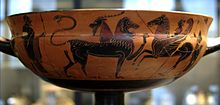Siana bowl

As Sianaschalen a genus of will Attic shells which have in the black-figure style were painted. They were named after one of their discovery sites, the necropolis of the ancient city of Siana on the island of Rhodes . In the second quarter of the 6th century BC, the Siana bowls were the predominant type of bowl in Athens . Even later this bowl shape was popular alongside the Kleinmeister bowls for a long time and was widely produced.
Siana bowls followed the Komast bowls designed by the Komast Group . The last representatives of the group began to make siana bowls. Typical of the bowls were the stepped mouth rims and the concave bowl base, which was higher than that of the Komast bowls. The handles point slightly upwards. The picture tones on the base of the bowl were a new development . The tondi were often framed by tongue bands or other ornaments and often show figures at the knee.
There are two different decoration systems for the exterior. There are pictures that are drawn over a bend marked with a circumferential line between the vessel basin and the edge of the vessel. These shells are called kink frieze shells (also known as “overlap”). On the other hand, both partitions could be painted separately, which is known as double-decker shells . The upper frieze is often designed ornamentally , mostly with plant patterns made from ivy or laurel branches. This form is mainly known from Eastern Greece. Animal friezes are comparatively rare. In the handle zone there may be figures, sometimes handle palmettes also appear . Popular subjects are symposia , comasts , cavalcades , duels, sporting and mythological scenes.
There were several vase painters who specialized in this form of bowl. The most important was the C painter . Also included were the Painter from Athens 533 , the Heidelberg Painter , the Painter from Boston CA , the Kassandra Painter , the Sandal Painter , the Civico Painter and the Raptor Painter . Today around 1000 bowls and fragments are known for which Herman AG Brijder has developed a classification that is fundamental for chronology and style development. A special form are so-called button- handle shells, the handles of which were fork - leg- shaped and ended in the shape of modern buttons.
literature
- John D. Beazley : Attic Black-Figure Vase-Painters. Clarendon Press, Oxford 1956.
- John D. Beazley: Paralipomena. Additions to Attic black-figure vase-painters and to Attic red-figure vase-painters. 2nd edition. Clarendon Press, Oxford 1971, pp. 23-29.
- John Boardman : Black-Figure Vases from Athens. A handbook (= cultural history of the ancient world . Vol. 1). von Zabern, Mainz 1977, ISBN 3-8053-0233-9 , pp. 34-37.
- Herman AG Brijder : Siana cups. Volume 1: The Siana cups and Komast cups (= Allard-Pierson Series. Studies in Ancient Civilization. Vol. 4, ISSN 0168-0153 ). 2 volumes: text and table volume. Allard Pierson Museum, Amsterdam 1983.
- Herman AG Brijder: Siana cups. Volume 2: The Heidelberg painter (= Allard-Pierson Series. Studies in Ancient Civilization. Vol. 8). 2 volumes: text and table volume. Allard Pierson Museum, Amsterdam 1991, ISBN 90-71211-20-7 .
- Herman AG Brijder: Siana cups. Volume 3: The Red-Black Painter, Griffin-Bird Painter and Siana cups resembling lip-cups (= Allard-Pierson Series. Studies in Ancient Civilization. Vol. 13). 2 volumes: text and table volume. Allard Pierson Museum, Amsterdam 2000, ISBN 90-71211-34-7 .
